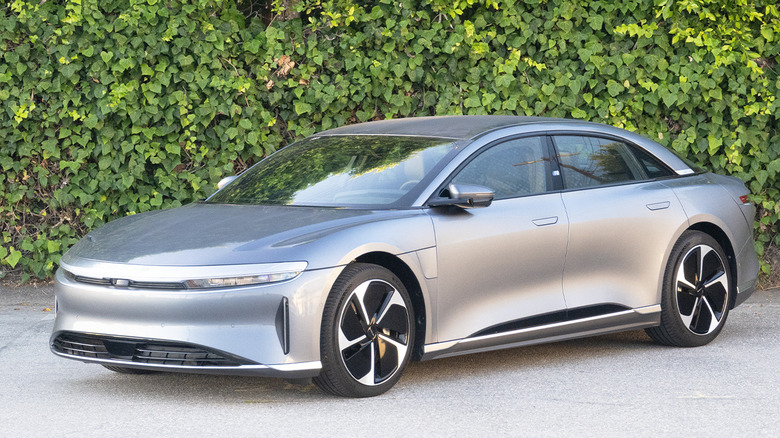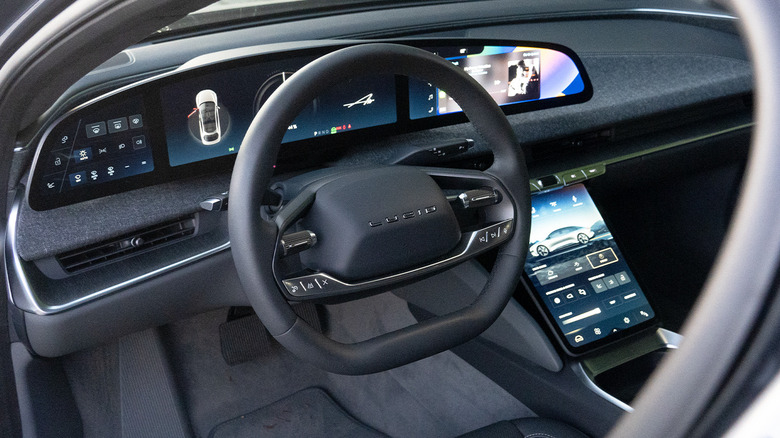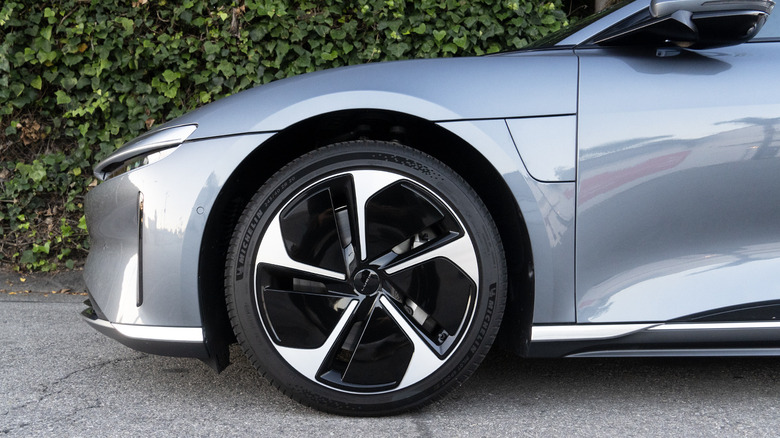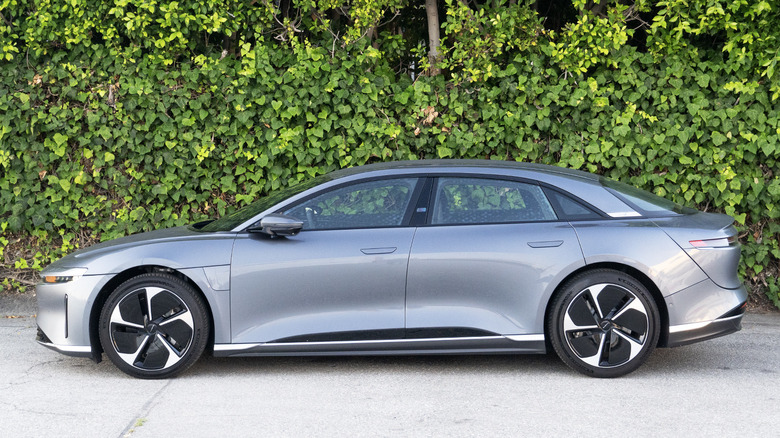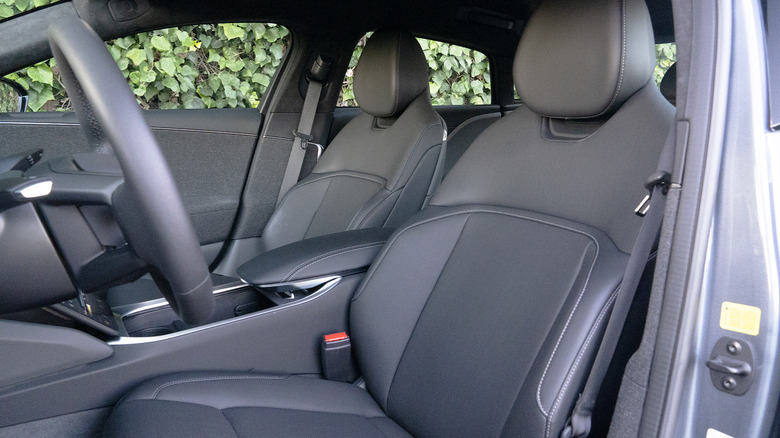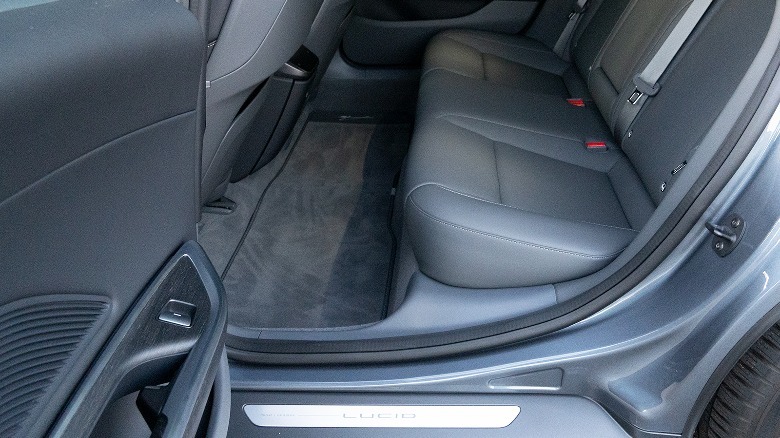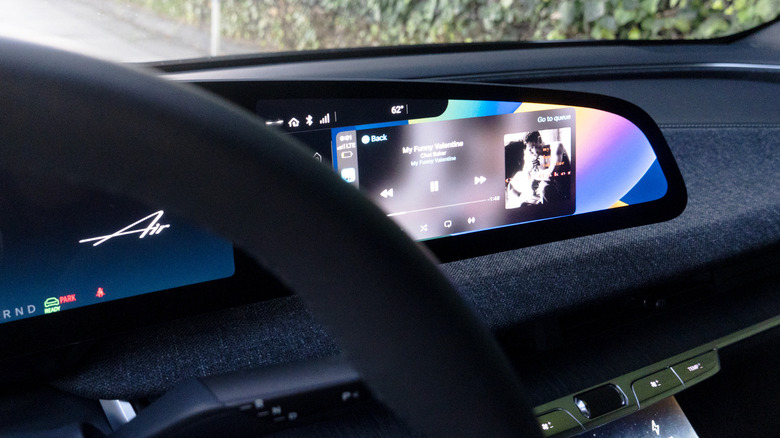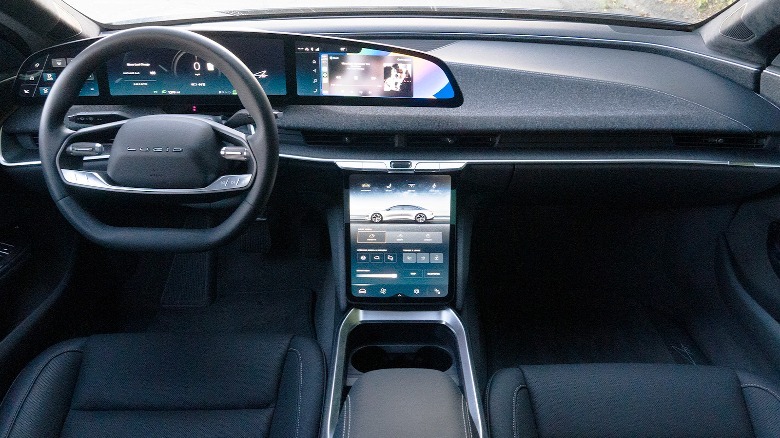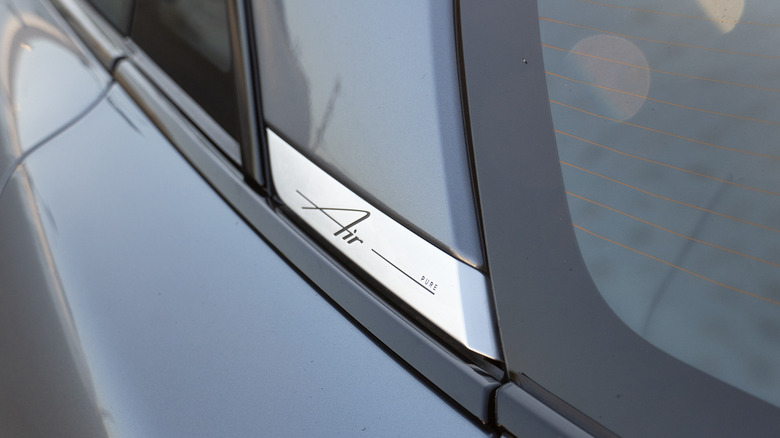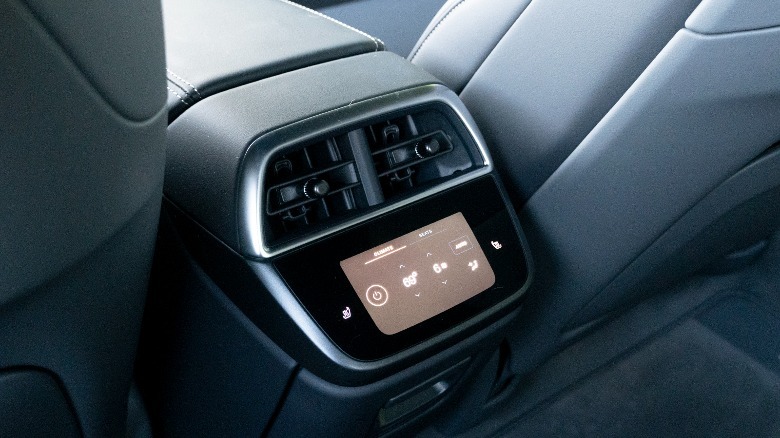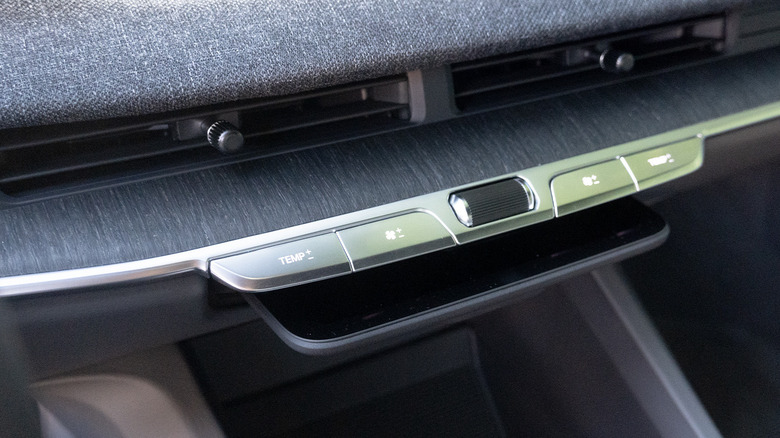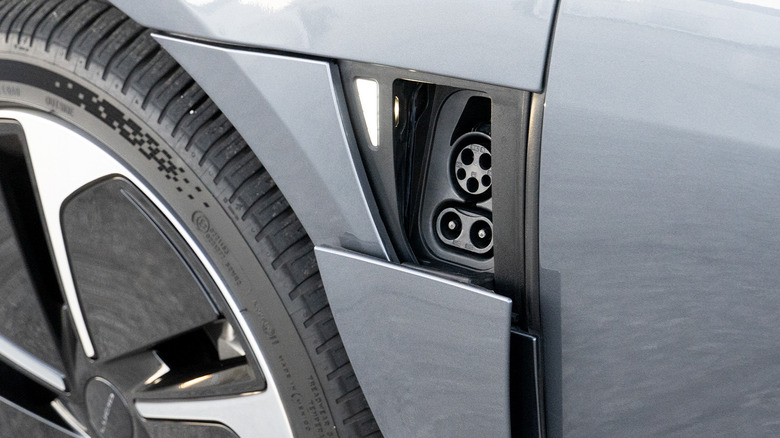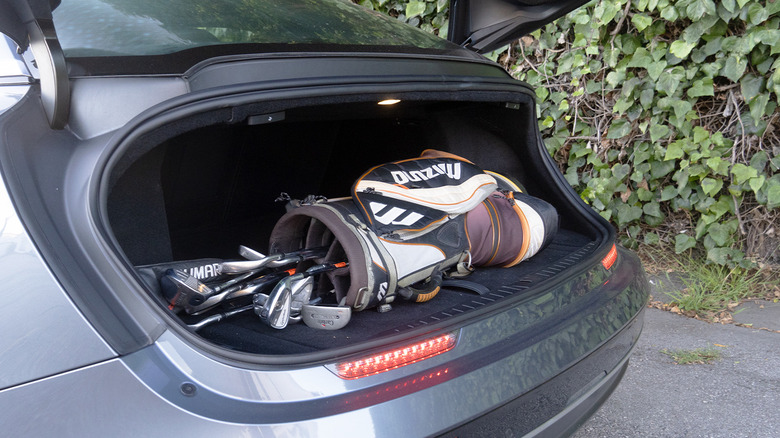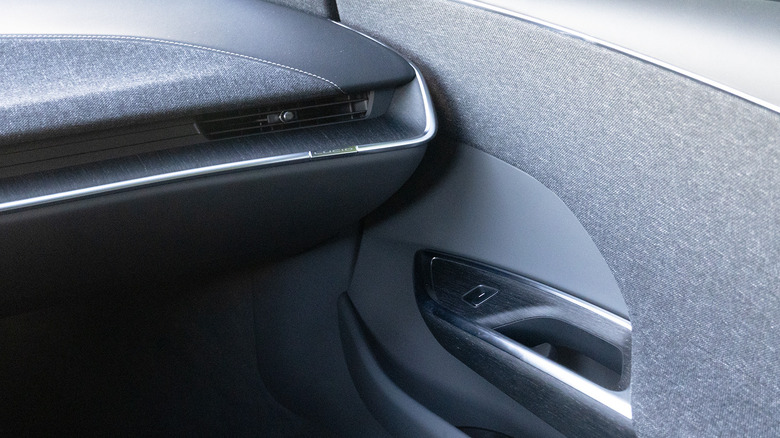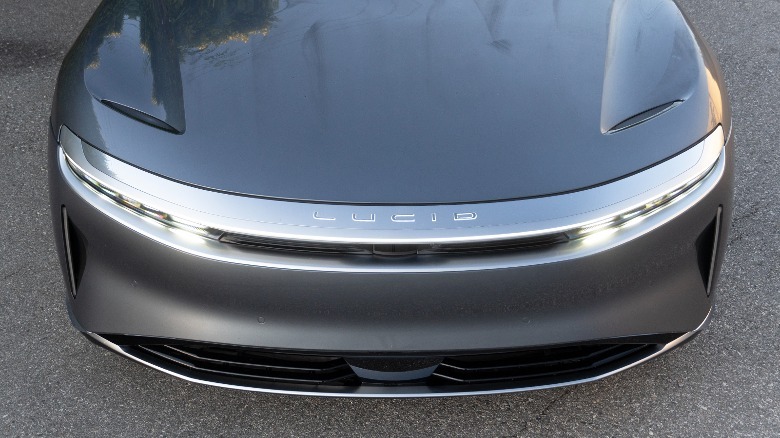2023 Lucid Air Pure First Drive: The Cheaper The Better
- The cheapest AWD Lucid Air available
- World-class range and power
- Style and driving dynamics on par with higher trims
- Build quality seems to be improving
- Now (finally) with wireless Apple CarPlay!
- Still costs $92,000 in AWD form
- Some minor UI issues
- Ventilated seats not available
A full four years after opening order books for the Air sedan as the EV with the world's longest available range, Lucid will finally begin deliveries of its cheapest Pure trim designed and priced to compete directly with the entry point of Tesla's Model S. After courting early adopting customers with cars promising up to 520 miles of range or 1,050 horsepower—but priced well into the realms of six-figures—the Pure moves (slightly) downmarket with less range and less output.
The Air Pure arrives solidly in the luxury segment, since even the "cheapest" version still starts at $87,400 and the dual-motor all-wheel-drive version that I recently tested adds up to at least $92,900 before tacking on options. But a price point for the first time below six figures presents something of a quandary for Lucid internally, from both a sales and an overall business strategy standpoint, so I climbed behind the wheel mostly curious to learn what exact differences the Pure can capitalize on when compared to more expensive Air trims.
Potent power in a pristine package
Even from the first moment, Lucid's stellar engineering shines through. I truly can't help myself: that instantaneously available torque just hooks me every time. But where the Air in Grand Touring Performance or even Touring trim levels, with 1,050 and 620 horsepower respectively, approach a point of punchiness that can truly border on painful, the Pure instead manages to deliver sufficiently stunning, if not overwhelming, power.
Even a gentle nudge into the accelerator pedal—can't call it a "throttle" or "gas" pedal in an EV—produces a brief sense of jerk, the scientific term for rate of change of acceleration. The rapid uptick in speed settles down around maybe 15 miles an hour as we reach peak torque delivery managed by traction and grip. Both the RWD and AWD Pure variants receive ratings of 480 horsepower, but the additional grip in this dual-motor undoubtedly helps keep the nose in check and the rear tires from spinning with so much torque, though the base Pure might well make tail-happy drifting quite easy should you be so inclined.
But that's in the default Smooth drive mode. Switching over to Swift or Sprint, the latter of which pops up a warning menu on the Air's almost intuitive touchscreen, adjusts the go pedal and traction control settings to allow for a bit more potent pop. Digging deeper into another screen let me turn off the traction control entirely to prompt easy wheelspin, though as with most electric vehicles, even "entirely" has its limits because a millisecond of truly zero grip would otherwise allow the electric motors to spin up to redline immediately.
Horsepower stats matter less these days
Torque stats matter much more than horsepower for EVs, so the Pure's official rating of 480 ponies regardless of RWD or AWD layout really doesn't mean much anyway. Rest assured that this luxury sedan will still rip around faster than almost everything on the market today, outside of the most expensive supercars, hypercars, or the highest-performing EV rivals. The optional 20-inch wheels do result in the EPA range estimate dropping to 384 miles, though, versus a car with 19-inchers netting 410 miles of range.
More importantly, the suspension and handling characteristics that originally made the more expensive Airs stand out from the rest of the heavy, rafting electric car market still carry over to the Pure. So canyon carving and weaving through traffic bring out the grins here, too. I spent most of my time in the Pure at freeway speeds, stomping hard and wondering what kind of wizardry could possibly mask the Pure's overall curb weight of 5,200 pounds—Lucid CEO and CTO Peter Rawlinson's history at Lotus always comes to mind.
Differences in the Air lineup
From more than 10 feet away, discerning the differences between the Air's trims becomes nearly impossible. Teensy tiny PURE lettering etched behind the rear quarter windows really serves as the only cue, but a number of discrete changes contribute to the price difference—probably the most important being the solid roof, as opposed to the massive piece of panoramic glass that transitions up from the windshield on more expensive trims.
That roof comes optional on the Touring, though (and certainly begs the question of what happens, and how much it might cost, if a rock chip starts spiderwebbing). Personally, living in usually warm and often quite hot Southern California, I prefer a solid roof anyway. But in an electric car, panoramic glass makes even less sense because cooling the cabin then requires much more energy consumption—and therefore negatively affects that all-important range. Such considerations battle against intimations of futuristic luxury, clearly.
Still, when I drove the Air in Grand Touring Performance trim from Los Angeles to Las Vegas on a single charge last year, even with the AC blasting in sunny conditions the whole way, the real-world range lived up quite well to Lucid's claims despite that enormous glass greenhouse. So with a solid roof, as on my Pure, I figure my potential range this summer might prove even more efficient.
A comfy cabin even at a lower price
Unfortunately, this Pure came without ventilated seats—which automakers tend to spec on even entry-level EVs because refrigerating passenger backsides uses far less energy than cooling entire cabins. Ventilated seats are also my single favorite automotive development of the past few decades, so the Pure's lack thereof, even as an option, comes as more than a minor surprise given the price point.
The seats themselves still nail a level of comfort that few other manufacturers can match. Think Rolls-Royce and Bentley, even. Lucid specs the Pure with so-called "vegan" or "PurLuxe" leather, a fancy way of describing modern fake leather, but the material manages to tread solidly in the luxury arena even if the "new car smell" ends up a bit different. I also enjoyed the contrasting cloth upholstery more than expected.
Other than the materials, the Pure's interior almost identically matches higher-priced Air variants. Smooth lines and crisp digital displays accentuate the efficient packaging that creates a much more spacious cabin than just about any car of similar size—including the Tesla Model S, against which Lucid benchmarked the Air's exterior dimensions.
The Air's uniquely futuristic design looks longer than the car actually is (and drives). Yet tiny proprietary motors and the skateboard platform create huge cavernous spaces for the deep frunk and rear clamshell trunk, with plenty of room for a family's worth of luggage, groceries for months, and/or multiple golf bags in addition to the roomy interior. Choosing either of the two lowest-priced trims, this Pure or the Touring, cuts out a single pack of batteries and thereby creates an even deeper rear passenger footwell, too.
CarPlay and connectivity conundrums
A big update for this car, which my previous GTP and Touring Airs lacked, arrived only a couple of months ago when Lucid announced an over-the-air update for all existing and new cars that integrates wireless Apple CarPlay to the innate user interface. The delay apparently involved Apple's demand that the actual CarPlay screen or subscreen remain rectangular, which presented a problem given that Lucid wanted CarPlay to reside within the curved upper screen rather than the rectangular, retracting lower screen that allows for easy selection of climate control functions, drive modes, and the Air's physical settings including steering wheel, mirror, and seat positions.
Lucid's solution places CarPlay in the best location, directly to the right of the steering wheel within the smaller almost triangular-ellipsoid screen. The placement, however, means that the actual CarPlay rectangle cannot maximize total surface area and ends up barely larger than an actual iPhone, so choosing different apps from the homepage or reading street names on map displays actually gets kind of difficult. And I have 20/20 vision.
CarPlay connected instantaneously each time I turned the Air on, other than the typically frustrating initial Bluetooth struggle. But Lucid's innate UI required me to then select an icon on the home screen, rather than automatically popping up with Spotify or Waze already open when I started up the electronic systems. Little gripes, I know, and perhaps something Lucid can play with on the next OTA update.
Focusing on the Air's NVH
While I miss raucous exhaust rumbles or supercharger whine or turbo whooshes in a car so quick, the futuristic impressions of driving an electric car definitely deliver a distinct appeal. Actually playing music in the Air, via Spotify or Apple Music or any other app, perfectly complements the radically different driving experience that EVs offer simply thanks to the lack of an internal-combustion engine soundtrack. And out of all OEMs, Lucid might have spent the most time focusing on NVH, or the reduction of noise, vibration, and harshness.
Even at freeway speeds, every Air somehow creates minimal wind noise until well into the triple-digits. A bit of tire hum developed in the Pure on portions of the 405, forgivable given the freeway's well-known bumps and expansion lines. A few faint rattles entered the cabin on the worst sections, but nothing that even Chet Baker's dulcet tones couldn't drown out easily—a testament to Lucid's steadily improving build quality that I noticed throughout this Pure, in contrast to previous Airs that arrived with a few stitch lines looking less than straight, a knob or button that refused to center properly, or even exterior trim panels out of line.
Despite a few such details, the first Air I drove in GTP trim impressed me as one of the fastest and most comfortable cars I had ever driven up to that point. The perfect seats and suspension paired with effortless power delivery at any time, even at highway speeds. When I tried using Lucid's Highway Assist function on the 15 North to Vegas, though, I found it ping-ponged between road lines and sometimes turned off unnecessarily. So when this Pure drove itself much more steadily on the 405, I began to suspect that perhaps Lucid's semi-autonomous software programming also received an OTA update.
Known Lucid issues still waiting for resolution
A few outstanding frustrations that welled up with the GTP and Touring Airs still carry over, however. The lack of an on-off button for the car always leaves me wondering whether someone might be able to hop in and drive when I walk away with the key—which still only sometimes locks the car and often incomprehensibly so. Do the side mirror folding in mean the car is locked? Who knows, since the RFID system activates when I approach to test the door handles, unlocking the car for certain. To truly test, I would have to put down the key a ways off, then walk up to the car. Not ideal.
Meanwhile, squeezing the key twice only sometimes prompts a honk to signify the doors are locked—sometimes not, though. (And the horn itself sounds pretty funky for a new car, as if the high and low pitches hit one after the other rather than simultaneously.) Safe to say, I never left my mirrorless camera in the Pure when I parked, since I never acclimated to the intricacies of the locking and on-off programming. But more time with the car might help grow my confidence (or at least reduce my paranoia).
Making a real-world range estimate
Of course, more driving with the Pure also would have helped paint a more accurate picture of real-world range. In my short time with the car, the onboard screens reported 57% of battery used for 169.3 miles of distance covered. Extending that figure out to 100% indicates 297 miles of total range, or a fair amount less than this Pure's official rating of 384 miles. But keep in mind that I spent almost all of those 169.3 miles driving as hard as possible, often at freeway speeds or higher, maxing out acceleration in different drive modes, the air conditioning blasting on a hot SoCal day with temps in the 80s and even low-90s.
Electric cars achieve ideal efficiency in just about the exact opposite conditions—in slow stop-and-go traffic while commuting on a cloudy day, for example. Other Lucids that I've driven performed similarly well under similar circumstances, so I gave back the Pure figuring that real-world range number is probably pretty accurate.
The constantly evolving EV market has changed in the years since the Air Dream Edition first achieved that world-record 520 miles of range, especially at the top of the market for luxury sedans where the Air competes. Obviously, the Tesla Model S that Rawlinson helped engineer needs a major update, though improvements to battery tech and programming now allow an EPA range estimate of 405 miles at the entry price point of $88,490. But given Elon Musk's incoherent antics, many customers may find a Lucid much more attractive at a similar price point (not to mention the gap in build quality, repairability concerns, as well as the differentiation via design ethos).
Competition in the growing luxury EV segment
Mercedes-Benz, meanwhile, continues to drop new models in the EQ lineup that aim to satisfy a more plush vision of electric luxury, with overboard tech, nautical styling, and less engaging driving dynamics. But the roomy EQS nonetheless seems perfect for a specific subset of EV buyers (retired dentists, as the joke goes). In contrast, the Audi e-tron GT and Porsche Taycan siblings from Volkswagen AG lean into the lowslung, more aggressive sport-sedan style. But those characteristics come at the cost of cramped interiors and far less range—while easily costing much more than the new Pure.
In fact, as much as the Pure now undercuts or at least solidly competes with the rest of the luxury EV market, to an extent this cheapest Air variant also presents a challenge for Lucid internally. Moving downmarket from six-figure hyper-sedans without a more significant differentiation other than range and output now makes that GTP, for example, at $179,000 a serious question of dollars spent per additional horsepower or mile of range.
A solid roof, high-quality interior, spectacular driving dynamics, and similar styling—all at almost half the cost—will likely make the Pure an easy choice for most buyers. As a spoiled rotten speed freak and dedicated road tripper, my hypothetical money would probably go to a Grand Touring hoping for the right balance of range and at least a bit more power. But in the real world, charging network infrastructure still needs radical improvement, meaning every Air is still a city car so the cheapest RWD Pure, therefore, might well be the best bet.
Hopefully the Pure can help
Next up, Lucid will introduce the Sapphire as a tri-motor, 1,200-horsepower Air that takes a big leap upmarket with a stupendous starting price tag predicted at a quarter-million bucks. The inevitable crossover SUV named Gravity should arrive shortly thereafter, but the company as a whole still faces the challenge of attracting sales as a basic requirement for converting continued investment into expanded production.
Plus, given how many friends and randoms still asked me what kind of car the Pure even was—and what percentage had never even heard of Lucid when I responded—overall recognition outside of early adopter EV fanatics still needs to improve, as well.
And that's a shame, one that the lower entry point of the Pure can hopefully solve, since everyone who drives an Air immediately understands that the team at Lucid somehow miraculously built the best EV on the market on their very first try. For everybody involved—including Lucid, Saudi investors, and the public, if not EV competitors—when it comes to any version of the Air, I solidly believe the cheaper the better.
